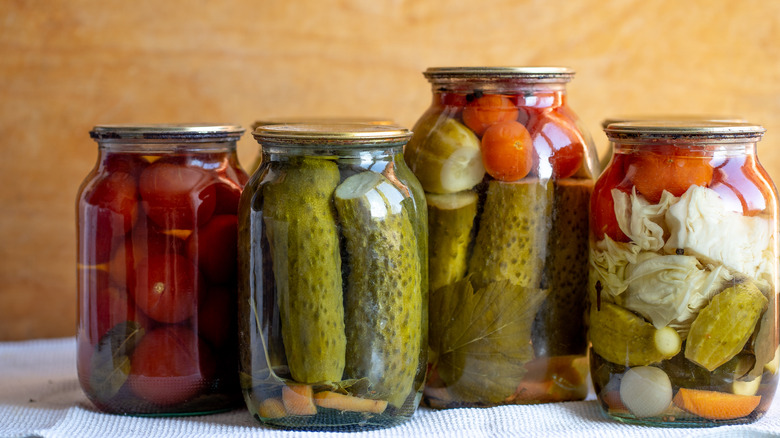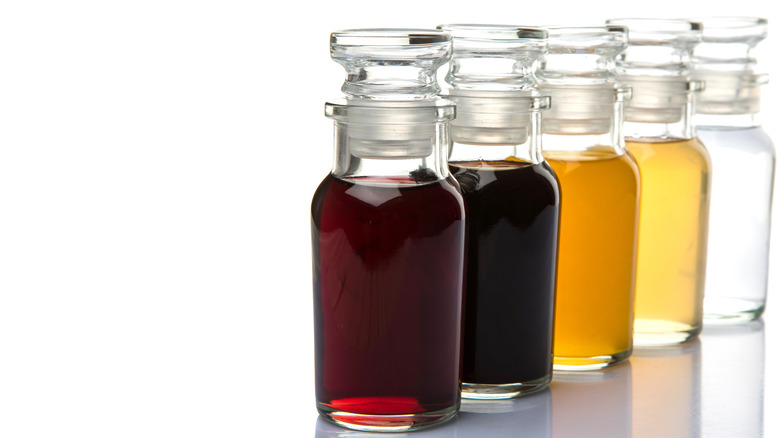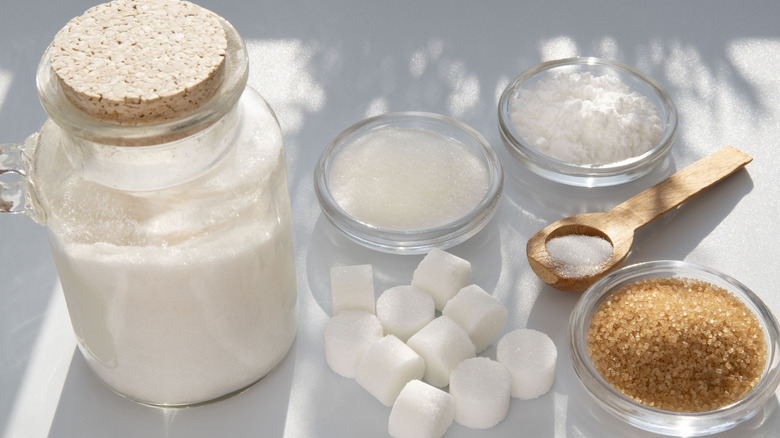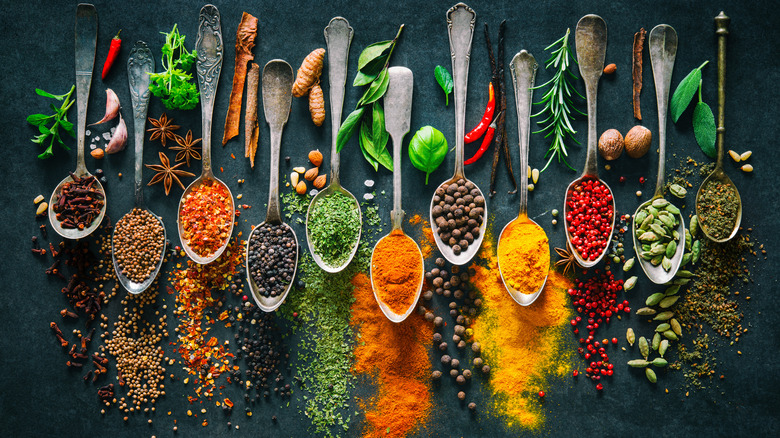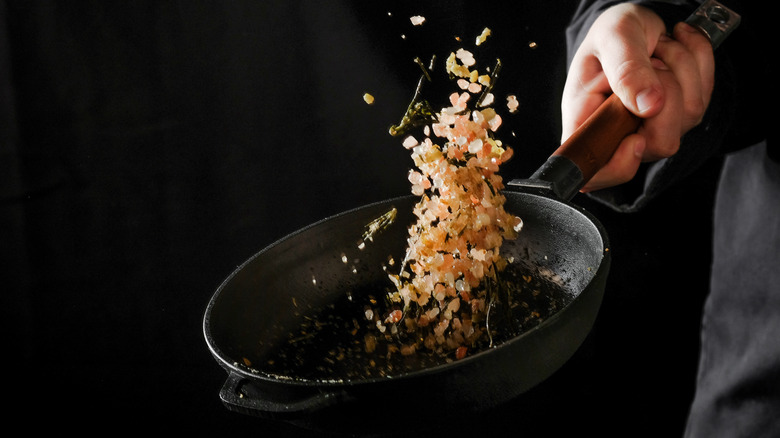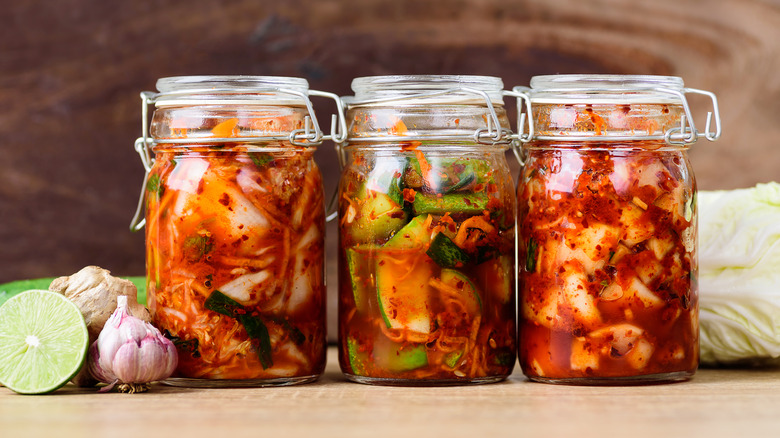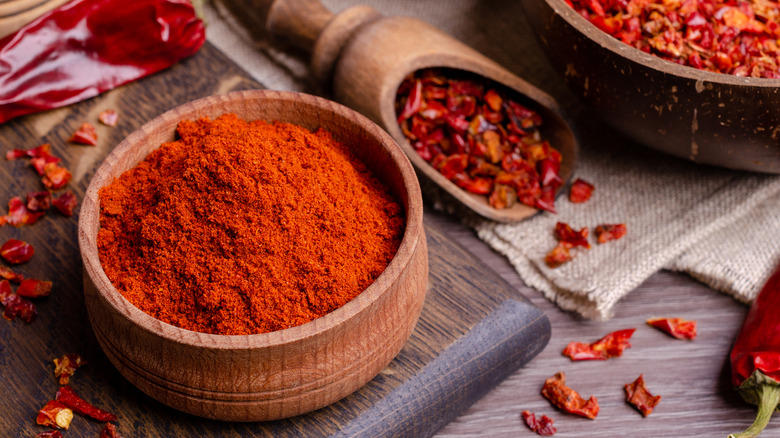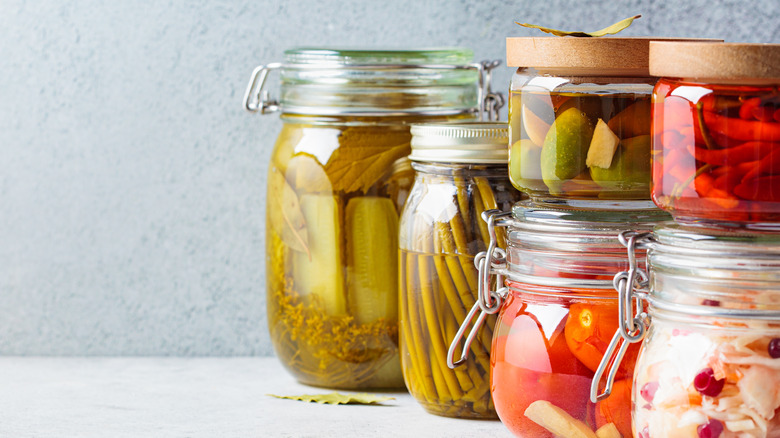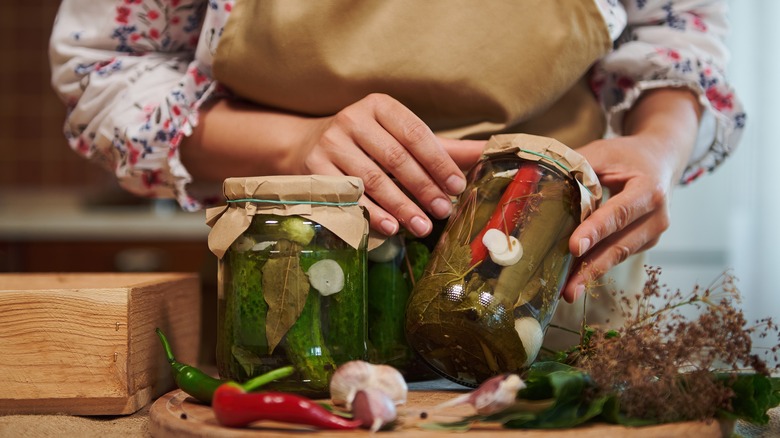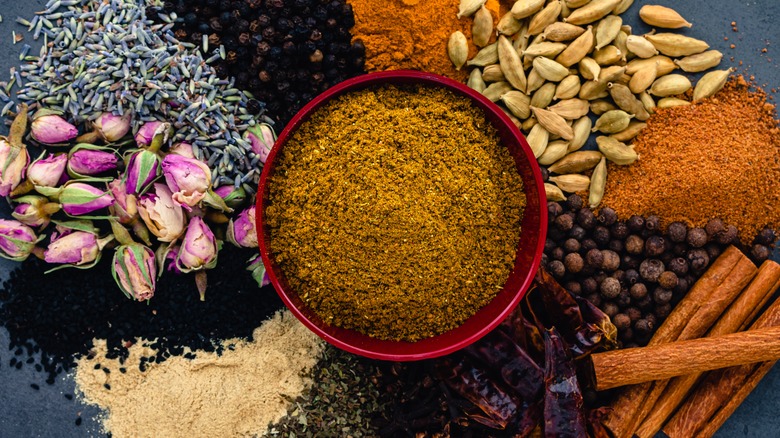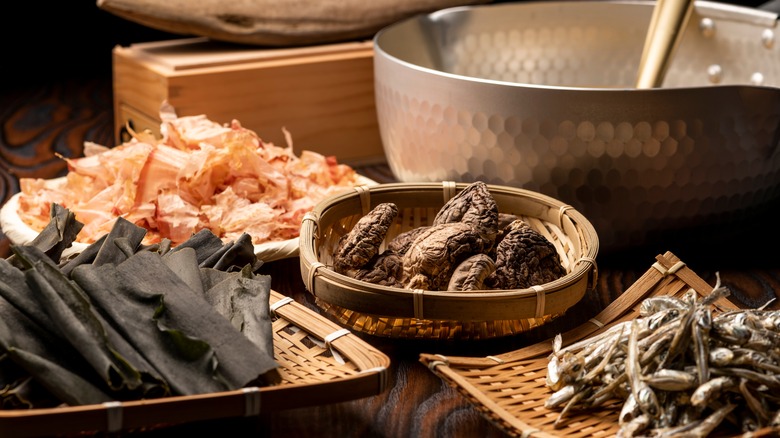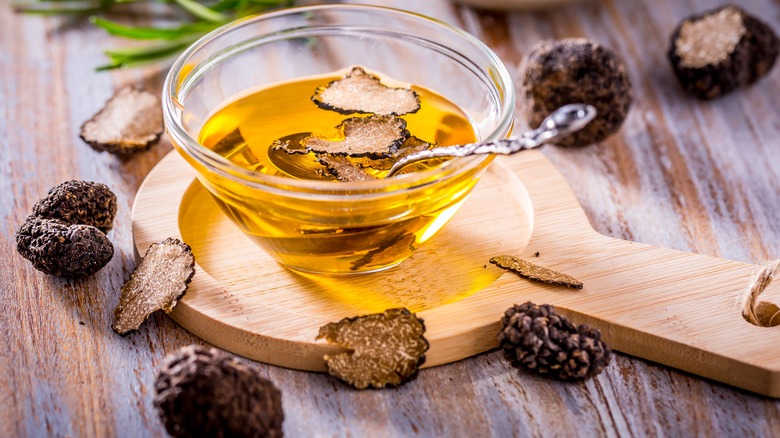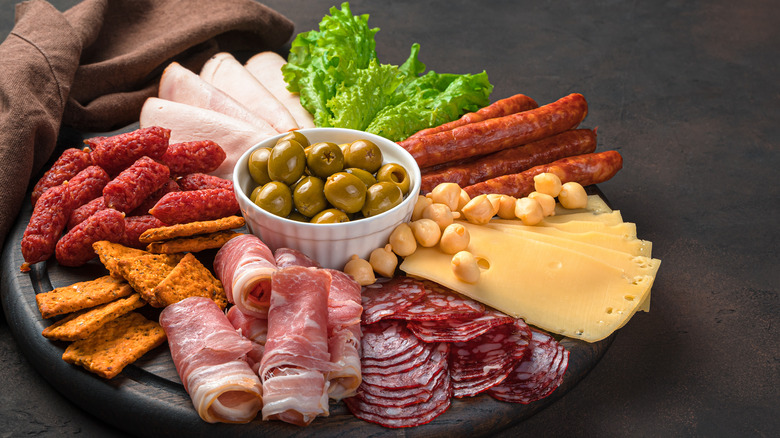13 Ways To Boost The Flavor Of Pickles
Pickles have long been a beloved snack, sandwich sidekick, and ingredient in various cuisines worldwide. They offer a unique combination of sour, salty, and sometimes sweet flavors that can elevate even the most ordinary dish. However, it's common for pickle enthusiasts to crave something new and different from their favorite briny treats.
Pickling is a versatile and accessible culinary technique allowing you to experiment with various flavors, textures, and ingredients. Whether you're a home cook, a culinary professional, or simply a pickle lover, you'll find that the world of pickling offers endless opportunities to let your creativity shine. One of the primary components of the process is the pickling solution, or brine, which typically consists of vinegar, water, salt, and various herbs and spices. The choice of vinegar, along with the specific blend of seasonings, can significantly impact the overall flavor of the final product. By experimenting with new and exciting tastes, you'll not only expand your palate but also develop a deeper appreciation for the humble pickle.
Experiment with different vinegar types
Most traditional pickle recipes call for distilled white vinegar, known for its sharp, clean flavor. Different types of vinegar can bring unique and intriguing notes to your pickling solution, resulting in a wholly new and exciting twist to your pickled creations.
Apple cider vinegar is popular among home picklers due to its fruity, slightly sweet taste. It lends a subtle depth of flavor that pairs particularly well with cucumbers, cauliflower, and other vegetables. Apple cider vinegar is also rich in beneficial enzymes and probiotics, so it's a nutritious option to consider.
Another exciting option is red wine vinegar, which adds a robust, tangy flavor to your pickles. This vinegar works especially well with red or purple vegetables, such as red onions and beets. Plus, the vibrant color of the red wine vinegar can make for a visually appealing result.
For a more luxurious touch, consider using balsamic vinegar in your pickling adventures. Known for its rich, syrupy consistency and sweet-tart taste, balsamic vinegar can elevate your pickles to new gourmet heights. Balsamic vinegar is very strong, so use it rarely or mix it with another vinegar to dilute the taste and get a more balanced flavor. Rice vinegar is another option worth exploring. With a mild acidity and delicate sweetness, rice vinegar is a common ingredient in Asian pickles. It's perfect for pickling cucumbers, radishes, and other crisp vegetables, lending them a refreshing and unique taste.
Add sugar for a touch of sweetness
Adding sugar to your pickling solution doesn't mean your pickles will end up overly sweet. In fact, a little bit of sugar can work wonders in counteracting the vinegar's acidity and the brine's saltiness. This can give your pickled vegetables a more balanced, harmonious taste that lets the natural flavors of the veggies shine through.
You can add a little sweetness to your pickles with several different types of sugar, each with its own taste and properties. White sugar, for example, is a common choice for many picklers. It dissolves readily in the brine and provides a clean, straightforward sweetness that doesn't overpower the other flavors in the pickles.
For a more nuanced sweetness, you might consider using brown sugar instead. Brown sugar contains molasses, which lends your pickles a rich, caramel-like flavor. This works particularly well with heartier vegetables like carrots or green beans, as well as with spicy pickles that could benefit from a subtle hint of sweetness to balance the heat.
Honey is another fantastic option for adding a touch of sweetness to your pickles. It offers a natural, floral sweetness that pairs well with various pickled vegetables and fruits. Plus, honey contains trace minerals and antioxidants, making it a healthier alternative to refined sugars.
Combine fresh herbs and spices
You can make your pickles more appetizing and appealing by adding multiple fresh herbs and spices into the mixture. Dill is perhaps the most iconic herb for pickles, and for a good reason. With its feathery leaves and unmistakable aroma, dill adds a fresh, slightly bitter note to pickles that is simply irresistible. When using dill, don't be shy — both the leaves and seeds can be added to the pickling brine for maximum flavor impact.
Garlic is another classic pickling ingredient, providing a robust, savory taste that complements a wide range of vegetables. For a more intense garlic flavor, try adding whole, peeled cloves to your brine. Alternatively, you can use minced or crushed garlic for a subtler taste.
Mustard seeds are a popular spice in pickling thanks to their unique ability to add a bit of heat and a pleasant, earthy taste. Yellow mustard seeds are milder, while brown or black mustard seeds pack a spicier punch. Whichever variety you choose, your pickles will benefit from their distinct flavor profile. Peppercorns are another versatile spice that can also be used to add a touch of heat and a gentle, aromatic spiciness to your pickles.
Toast spices for added depth
One secret way to improve the flavor of homemade pickles is to toast spices before putting them in the brine. Toasting, also known as blooming spices, is a simple process that only takes a few minutes of your time but can add significant value in the end. The taste of your pickled vegetables can be greatly changed by toasting spices. This is because toasting spices cause the natural oils of a spice to be released, which in turn amplifies the flavors.
Start the toasting process by placing a dry skillet over medium heat, then add your spices to the pan. It's crucial not to overcrowd the skillet, as this can lead to uneven toasting and even burning. As soon as the spices heat up, you'll smell an amazing aroma in your kitchen. This is a sign that the essential oils within the spices are starting to release. Stir the spices gently and frequently to ensure even toasting, and keep an eye on the color. You're looking for a slight darkening of the spices, but be cautious not to let them burn. Burnt spices will impart a bitter taste to your pickles, which is definitely not the flavor boost we're aiming for! When the spices have reached the desired level of toastiness, take them off the stove and set them aside to cool. As the temperature drops, the flavors will continue to develop, ensuring that your pickles will be packed with a robust and well-rounded taste.
Explore international pickling styles
Pickling has been a cherished culinary tradition across cultures and continents for centuries. You can embark on a global flavor journey and broaden your pickling horizons by exploring various pickled vegetable styles from around the world. Each culture's unique ingredients, techniques, and flavors offer inspiration and insight that can be incorporated into your pickling adventures.
Korean cuisine is well-known for its staple side dish, kimchi. Made from fermented vegetables, most commonly Napa cabbage, and seasoned with a flavorful blend of spices, kimchi boasts a tangy, spicy, and umami-rich taste. Experiment with traditional Korean ingredients like gochugaru (Korean red pepper flakes), fish sauce, and ginger to create a classic kimchi recipe.
India's pickling traditions, known as achaar, incorporate a variety of fruits, vegetables, and spices to create an aromatic, spicy, and tangy delight. Indian pickles often use mustard oil as a base and feature spices such as fenugreek, fennel, and turmeric.
Japanese pickles, or tsukemono, offer a more subtle, delicate flavor profile. Typically made using a salt or vinegar brine, tsukemono pickles can range from mildly sweet to refreshingly sour. Popular Japanese pickles include umeboshi (pickled plums) and takuan (pickled daikon radish). Try your hand at making tsukemono by incorporating traditional Japanese ingredients like mirin, kombu, and shiso leaves.
Incorporate flavored salts
Salt is a fundamental ingredient in pickling, helping preserve and season your pickled vegetables or fruits. While regular table salt or kosher salt may be the go-to choice for many picklers, why not kick things up and try incorporating flavored salts to give your pickles an added layer of flavor and complexity?
Flavored salts combine salt with various herbs, spices, or other flavorings, resulting in a versatile seasoning that can add a unique twist to your pickles. With a wide variety of flavored salts available on the market, the possibilities for enhancing the taste of your pickles are virtually endless.
Herb-infused salts, such as rosemary or thyme salt, can introduce a delightful, aromatic quality to your pickles. These salts work particularly well with vegetables like green beans, asparagus, or zucchini, allowing their natural flavors to shine while adding an extra touch of herbal goodness.
When using flavored salts in your pickling brine, be mindful of the seasoning's intensity and adjust the amount accordingly. You may need to use slightly less flavored salt than you would with regular salt, depending on the potency of the flavorings.
Add some heat with spicy peppers
For those who love a little spice in their lives, adding heat to your pickles can be a game-changer. Incorporating spicy peppers into your pickling brine will create pickles that pack a punch and leave a lasting impression on your taste buds. Spicy pickles are a great way to spice up your favorite foods like burgers, sandwiches, or even salads. They add a pleasant burst of heat that makes you want more.
There are a lot of different hot peppers to choose from, and each one has its own amount of heat and flavor. You can use jalapeño for a milder kick. They have a bright, tangy flavor and a light heat. Slice or chop the jalapeño and add them to your canning brine.
If you're looking for more intense heat, you might opt for spicier peppers like serranos or even habaneros. As when you cook with chiles, using these hotter peppers requires you to exercise caution, as their heat can be quite potent. To avoid overwhelming your pickles, consider adding just a small amount of chopped peppers to your brine or even using whole peppers for a more subtle effect.
Experiment with different pickling times
When it comes to pickling, timing is everything. The amount of time you allow your ingredients to soak in the pickling brine can significantly impact the final flavor, texture, and overall enjoyment of your pickles. By experimenting with different pickling times, you can discover the perfect balance between tangy, briny flavors and the crunchiness or softness you desire in your pickled treats.
A good rule of thumb for beginners is to start with a shorter pickling time, then work your way up as you gain comfort with the process. As you become more adventurous, you can experiment with longer pickling times. A week-long soak, for instance, will result in a much bolder and tangier pickle. You may also notice a change in the texture as the cucumbers become softer and more pliable.
Keep in mind that the ideal pickle time will depend heavily on your own particular preferences and tastes. If you want a quick and hassle-free way to pickle, try using a refrigerator pickling recipe, which involves immersing your chosen ingredients in a vinegar-based brine and storing them in the fridge for a specific period of time. This technique results in a milder, fresher-tasting pickle with a firmer texture, perfect for those who enjoy a crunchier snack.
Try fermentation for a probiotic boost
Fermentation is a terrific way to preserve foods for longer periods of time, and it can also be good for your health in a number of ways. Fermented foods are full of probiotics, which are good bacteria that support a healthy gut microbiome and promote general health.
For fermenting pickles, start by creating a brine using water and salt. Submerge your chosen vegetables in the brine, ensuring they are fully covered, and then seal the container with an airlock or fermentation weight. This allows the gases produced during fermentation to escape while preventing oxygen and contaminants from entering the jar.
As the beneficial bacteria consume the natural sugars in the vegetables, they produce lactic acid, which creates the tangy flavor characteristic of fermented pickles. As time progresses, the vegetables will soften, and the flavors will become more complex.
To ensure a successful fermentation, you must monitor your pickles regularly, checking for signs of spoilage or mold. If you notice any off-odors or unusual growths, it's best to discard the batch and start again. Once your fermented pickles have reached the desired flavor and texture, transfer them to the refrigerator to slow the fermentation process and preserve the quality.
Create your own pickling spice blends
When creating your pickling spice blends, it's essential to consider the balance of flavors. Aim for a harmony of sweet, savory, and spicy elements that will complement the natural tanginess of the pickles.
For a sweeter blend, consider adding spices like cinnamon, cloves, or allspice. These warming spices can add a subtle sweetness that pairs well with fruits or sweeter vegetables like beets and carrots. You could also add bay leaves, black peppercorns, or juniper berries to your pickling brine for a more savory flavor. These ingredients can give your brine more depth and variety.
If you like your pickles to have a bit of heat, add ingredients such as red pepper flakes, cayenne pepper, or even whole dried peppers. These fiery additions can bring a delightful kick to your pickles, making them perfect for those who crave a bit of spice.
Once you have settled on a final blend of spices, store them in a jar or other container with a secure top and mix them well. Remember that whole spices will retain their flavor longer than ground spices, so opt for whole spices whenever possible. When you're ready to pickle, simply add your custom spice blend to the brine, allowing the flavors to meld and infuse your pickles with your signature touch.
Add umami-rich ingredients
Adding umami-rich ingredients to your pickling brine can create pickles that boast a mouthwatering, complex taste sensation that is both satisfying and delicious.
There are many kinds of umami-rich substances, but some more common ones are fish sauce, miso, Worcestershire sauce, and soy sauce. These ingredients are known for having a lot of glutamates, an amino acid that gives umami its typical rich, savory taste. When added to your pickling brine, these ingredients will give your pickles a new umami flavor, making them a memorable addition to your pickling repertoire.
To incorporate umami-rich ingredients into your pickling process, select one or more ingredients that complement your chosen vegetables or fruits. For example, you might choose a splash of soy sauce or miso in brine for pickling radishes, turnips, or even mushrooms. You can also pickle cucumbers, green beans, or even cabbage by adding a few drops of Worcestershire sauce to the brine.
Use flavored oils for a unique texture
While vinegar and brine are the stars of the pickling show, flavored oils can also play a supporting role, offering a unique texture and additional layers of flavor to your pickles. From subtle infusions to bold and aromatic blends, using flavored oils in your pickling process can add a rich, velvety quality that sets your pickles apart from the rest.
You can enhance the flavor and texture of your pickles by including flavored oils in the pickling brine or drizzling them on top of the completed product. Some examples of flavored oils include garlic-infused olive oil, chili oil, and truffle oil. Choose a flavored oil that goes well with the other components of your pickling recipe, and make sure to use a small amount so as not to obscure the original taste of the freshly selected veggies or fruits. To incorporate flavored oils into your pickling process, add a small quantity of oil to the pickling brine or directly to the jar before sealing. This will infuse the oil's flavor throughout the pickles as they marinate, creating a subtle yet delicious undertone that enhances the overall taste experience.
Pair pickles with complementary foods
A key to truly appreciating the delightful flavors of your homemade pickles is knowing how to pair them with the right foods. When chosen thoughtfully, these pairings can elevate the taste of both the pickles and their accompanying dishes, creating a harmonious culinary experience that celebrates the best of both worlds.
One classic pairing for pickles is a simple cheese and charcuterie board. You may cut through the richness of the cheeses and cured meats with the acidic and briny flavors of pickles, which provide a crisp and refreshing contrast that keeps your palette engaged. You can find the ideal complement for your pickles by experimenting with a variety of cheeses and meats.
Sandwiches are another fantastic canvas for pickles, where they can provide a burst of acidity and crunch to balance out the other ingredients. From a classic Reuben recipe with sauerkraut to a Cuban sandwich with dill pickles, the possibilities are endless when it comes to incorporating your homemade pickles into your favorite bready creations.
Pickles also make a delightful addition to salads, where their acidity can brighten up the flavors of the other ingredients and provide a satisfying crunch. You may, for instance, include pickled beets, carrots, or onions in a salad made with leafy greens. Alternatively, you could prepare a dish with a Greek-inspired flavor profile by combining pickled cucumbers with tomatoes, onions, and feta cheese.
Static Media owns and operates Tasting Table and Mashed.
